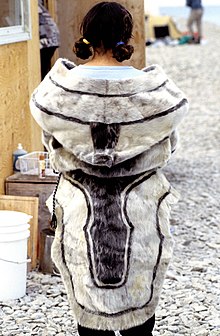Amauti

| Part of a series on |
| Indigenous peoples in Canada |
|---|
 |
|
|
The amauti (also amaut or amautik, plural amautiit)[1] is the parka worn by Inuit women of the eastern area of Northern Canada.[2] Up until about two years of age, the child nestles against the mother's back in the amaut, the built-in baby pouch just below the hood. The pouch is large and comfortable for the baby. The mother can bring the child from back to front for breastfeeding or for eliminatory functions without exposure to the elements.[2] This traditional eastern Arctic Inuit parka, designed to keep the child warm and safe from frostbite, wind and cold, also helps to develop bonding between mother and child.[3]
Naming
| language[4] | long-tailed style amauti | skirted style amauti |
|---|---|---|
| Iñupiaq | not used | amaaġun ~ amaunnaq |
| Nattiliŋmiut | akulik | amauti |
| Inuinnaqtun | ᐊᑯᖅ akuq | ᐊᒪᐅᑎ amauti |
| Caribou Inuit | ᐊᑯᖅ akuq | ᐊᖏᔪᖅᑕᐅᔭᖅ angijuqtaujaq |
| North Baffin dialect | ᐊᑯᖅ akuq | ᐊᖏᔪᖅᑕᐅᔭᖅ angijuqtaujaq |
The making of the amauti
The amauti can be made from a variety of materials including sealskin, caribou skin or duffle cloth (a thick woollen cloth) with a windproof outer shell. Children continue to be commonly carried in this way in the eastern Arctic communities of Nunavut and Nunavik, but the garment is sometimes seen in the Northwest Territories, Greenland, Labrador, Russian Arctic and Alaska. Cloth amautiit have gradually displaced skin garments.[5]
The child's placement in the garment
Many external viewers think that the child is carried in the hood of the amauti, and this erroneous depiction can be seen in many works of art.[6] This is not the case. The hood is enlarged in an amauti to permit both child and mother to be covered together, while the child is actually carried in the enlarged and extended back of the garment. The child rides with his or her belly against the mother's back and with knees bent. The garment is secured at the waist with a tie or belt which prevents the child from slipping down from the pouch. The weight of the child is carried across the shoulders of the garment although this weight is typically re-distributed by two more ties which form a "v" from the collar bone, with the base secured by the tie at the waist. A final tie attaches to the front edge of the hood, permitting the mother to either open the hood for a curious child to emerge and take in the surroundings, or to pull the hood across closing the child away from the wind and elements.
Winter and summer clothing


There are usually two styles of amauti: skirted style akulik, like a dress (shown on the right, with the two women); and long-tailed style angijuqtaujaq, a longer back with a stylized tail-like hem at the back (shown on the left picture-white). Hood shape, decoration and tail shape all speak to the region of origin of an amauti. The sleeves and hem on a winter amauti are trimmed with solid colour stripes which emphasize the feminine/maternal cut, and the swing of the "tail". The winter amauti is classically seen with a white cotton cover (silapak), but also in other solid colours, with an inner duffle inner layer, also trimmed, in a darker solid colour.
In the past, the longer amauti tails were decorated with talismans such as beads, shells and pierced coins, although disapproval of these talismans as "heathen" by the church reduced the frequency within which they were used. The talismans were said to attract spirits to the swinging tail and thus protect the ovaries (and fertility), located at the front, from attracting spirit attentions.
Not shown are the more modern summer amauti which have no sleeves, less insulation, and permit a child to be carried while berry picking or in other summer occupations. They are also used during the winter months of the year, used with an oversized parka covering both mother and baby. The summer amauti is typically made from quilted cloth in any number of patterns.
Amauti as style
In 2007, an amauti beaded by Ooloosie Ashevak, the daughter-in-law of well-known Inuit artist, Kenojuak Ashevak, sold at auction for $19,200 at Waddington's after being estimated at $4,000 to $6,000.[7]
References
- ^ "Asuilaak Living Dictionary". Archived from the original on 2021-12-24. Retrieved 2008-09-30.
- ^ a b Issenman, Betty Kobayashi (2007). "The Art and Technique of Inuit Clothing". McCord Museum. Archived from the original on 2021-12-24. Retrieved 2012-04-02.
- ^ Karetak, Rhoda Akpaliapik; King, J. C. H. ed; Pauksztat, Birgit ed; Storrie, Robert ed (2005), "Amautiit", Arctic clothing of North America: Alaska, Canada, Greenland, China: C & C Offset Printing Co., Ltd, p. 80, ISBN 0-7735-3008-8
{{citation}}:|first2=has generic name (help) - ^ "Inuktut Glossary | Inuktut Tusaalanga".
- ^ Issenman, Betty Kobayashi (1997). Sinews of Survival: The Living Legacy of Inuit Clothing. Vancouver, B.C.: University of British Columbia Press. p. 166. ISBN 0-7748-0596-X.
- ^ Frances Loring, National Gallery of Canada
- ^ "Waddington's Auction House". Archived from the original on 2007-09-28. Retrieved 2007-05-06.
